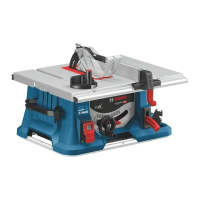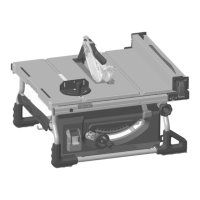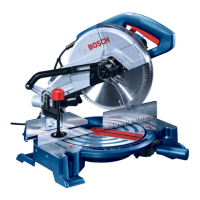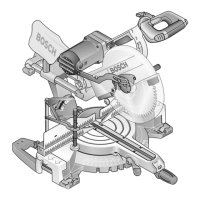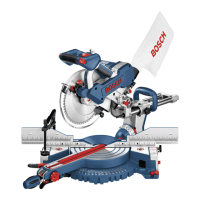English–91 619 P03 456 • (05.11) PS
Mounting the Auxiliary Parallel Fence
(see Figure )
Insert the attachment screws 47 through the drillings
on the side of the parallel fence. The heads of the
screws serve for the positioning of the auxiliary parallel
fence.
Slide the auxiliary parallel fence over the heads of the
attachment screws.
Place the washers 46 on the attachment screws,
screw on the wing nuts 45 and tighten.
Mounting the Angle Guide
Insert the rail 48 of the angle guide 9 into one of the
guide groove 7 provided on the saw table.
(see Figure )
For better support of long work pieces, the angle guide
can be widened with the profile 49.
As required, mount the profile to the angle guide with
the attachment set 50 provided. (see Figure
)
Stationary Mounting
(see Figure
)
To ensure safe handling, the power tool
must be mounted on a flat and stabile
working surface (e.g., workbench).
Attach the power tool with suitable screw fasteners to
the working surface. The holes 13 serve for this pur
pose.
5 OPERATING INSTRUCTIONS
Changing the Tool
Before all work on the machine, pull the mains
plug.
Select a saw blade suitable for the material to be
worked.
Use only saw blades whose allowable rotational speed
is as least as high as the noload speed of the power
tool.
Use only saw blades that comply with the characteris
tic data given in these operating instructions and have
been tested according to EN 8471 and appropriately
marked.
Take care when changing the saw blade that the tooth
offset is wider and the main body of the saw blade is
thinner than the thickness of the riving knife.
Removing the Saw Blade
Place the power tool in the transport position.
(See Section "Mounting the Table Insert")
With a commercially available screwdriver, pry up the
table insert 3 at the front (see Figure ) and remove
it from the tool well.
Place the power tool in the working position.
(See Section "Mounting the Protective Hood")
Swing back the protective hood 5 to the stop.
Turn the hexnut 54 with the ring spanner 51 (23 mm)
provided and pull the spindle lock 52 at the same time
until it engages. (see Figure )
Hold the spindle lock pulled and unscrew the hexnut
54 in the counter clockwise direction.
Take off the clamping flange 53. Remove the saw
blade 6. (see Figure )
Mounting the Saw Blade
If necessary, clean all parts to be mounted.
Place the new saw blade on the tool spindle 55.
(see Figure )
When mounting, observe that the cutting
direction of the saw teeth (arrow on the
saw blade) agrees with the direction of the
arrow on the protective hood!
Place on the clamping flange 53 and the hexnut 54.
Pull the spindle lock 52 until it engages and tighten the
hexnut 54 in the clockwise direction with a tightening
torque of approx. 15 23 Nm.
Reinsert the table insert plate 3.
Swing the protective hood 5 back down.
Dust/Chip Extraction
Take protective measures when dust is pro>
duced while working that can be detrimental to
health, combustible or explosive. For example,
some dusts are considered carcinogenic. Wear a dust
protection mask and use dust/chip extraction, if it can
be connected.
External Dust Extraction
Use a suitable adapter from the Bosch accessory pro
gram to connect a vacuum cleaner to the sawdust
ejector 35. Firmly attach the adapter and vacuum
cleaner hose.
The vacuum cleaner must be suitable for the material
to be worked.
When vacuuming dry dust that is especially detrimen
tal to health or carcinogenic, use a special vacuum
cleaner.
E
F
G
H
I1
I2
I3
I3
GTS10_WEU.book Seite 9 Mittwoch, 2. November 2005 2:05 14

